 Research Article
Research Article
Taxonomy of Types of Children’s Perceptions of a Protected Natural Area
Amparo Carretón Sanchis, Faculty of Teaching, University of Valencia, Spain
Received Date:December 15, 2023; Published Date:January 11, 2024
Summary
The evident distance between children and the natural environment raises concerns about the loss of understanding and interactions between environmental elements and their surroundings. In this study, three types of environmental elements are considered: abiotic, biotic and anthropic. The types of childhood perceptions that children who live in space have been investigated Protected Natural Area (PNA). To do this we analyzed 421 drawings sketched by children of 5 years of Early Childhood Education who live in each of the towns included in this PNA of Valencia (Spain): the Albufera Natural Park. With qualitative and quantitative methods, we analyzed what types of elements predominated in each outlined perception and what groups of perceptions had been drawn more and less frequently. From the results, it was possible to establish a taxonomy of six groups of homogeneous perceptions depending on the environmental elements that had been drawn most frequently. Our findings indicate that the perceptions of children who live in an PNA show a notable disconnection of biotic elements from their natural environment and, on the contrary, a considerable link to anthropic ones related to their urban environment.
Keywords:Early childhood education; Environmental elements; Environmental perception types; Protected Natural Area; Drawings
Introduction
An environment could be defined as the amalgamation of all the elements that influence an ecological community. Likewise, it could be added that the interaction between these elements determines the structure and viability of both the environment itself and the living beings that surround it they inhabit. However, Bertrand [1] considers that it is not simply the sum of some elements but the result of the dynamic and, therefore, unstable combination of physical elements, biological and anthropic that, interacting dialectically with each other, make a whole unique and inseparable in continuous evolution.
Children perceive the environment and its elements1 as part of their life and they build relationships between the different contexts in which they interact [2]. This interaction multisensory and experiential shapes the way each child understands and relates to its environment and the environmental elements that make it up. Tuan [3] argues that experiences of those who occupy a space make that place meaningful to them. For this reason, each child develops a unique internal representation, since it is intrinsically linked to their experiences and experiences with their environment, a complex system made up of elements biotic, abiotic, and anthropic that children need to discover and explore, given that they are agents that develop their expression and surprise in the face of a new world [4]. In a way, each child’s drawing and perception will depend on the lived experiences and interactions in the environment of each child, since we do not see the space of the world, but rather we live our field visual.
It should be noted that the act of perceiving is a learning process that the child begins in the place where it is born and the environment where it grows and develops. Perception is the first stage in human communication [5,6]. The way to know the environment and its elements is through “living it”, that is, through experiences, since the perception of the environment is an active and not passive process in which people can evaluate and define it according to their interests or needs [7,8]. In this way meaning and value are given, depending on your own needs, opportunities, and context in which you are located [9].
However, the growing disconnection between people and nature has often been related to rapid urbanization and the reduction of daily contact with nature, which has resulted in a reduction in interactions and experiences both in childhood and throughout life [10-14]. All of this leads to so much talk about the loss of interactions of people with the natural environment, as well as the serious consequences that this fact can lead to [13,15-18]. Which shows that many children have hardly any chance of living experiential experiences with nature or with biotic elements, even living near these natural environments.
As a consequence of these facts, more and more authors support the benefits that has an education for children in contact with nature and outdoor activities, since that there are many possibilities, it offers for well-being in all areas of your life [19-25]. Therefore, it is vitally important. That schools encourage interaction with the natural environment and with the different elements that it houses, so that the little ones learn to relax, to use the natural space, to solve fears and knowing how to relate to the different environmental elements and, above all, to take responsibility for the consequences of their actions on the environment [20,26]. In addition, contact with nature and outdoor activities helps them develop social skills, such as communication, cooperation, and empathy, which leads to reinforcing, from a very early age, emotional harmony, security, and self-confidence.
The environment in which we focus our study is the Albufera Natural Park, an PNA that is located 10 km from the city of Valencia (Spain). Those environments that have the distinction of PNA encompass threatened natural systems or of special ecological, scientific, landscape, geological or educational and are dedicated, especially, to the protection and maintenance of the biological diversity, geodiversity and associated natural and cultural resources [52]. This environment, in addition to being recognized as an PNA, is also a Wetland of International importance with Ramsar site n°454 [51]. At the same time, it constitutes one of the most important restinga-albufera systems in the region. Mediterranean Europe, basically, is considered “an example of human-nature interaction” [27].
Taking into account this approach and that the selected sample lives in an PNA with different types of natural environments (lake, coastal sandbank, dunes, wetlands, pine forests, etc.) we consider the following questions: What type of environmental perceptions do 5-year-old children who live in in this PNA? What types of environmental elements will be drawn most frequently? That type of perception will be the one most outlined by the participants?
Methodology
The objective of this study is to determine a taxonomy with the different types of perceptions environmental conditions of the child population living in an PNA. To address our objective, we present a methodological proposal that allowed grouping, systematizing, and describing the perceptions environments drawn by the sample. This is an innovative methodology, since it has considered a descriptive cross-sectional design [28] with a focus mixed methodological [29,30] based on employment simultaneous use of qualitative and quantitative methods [31] with the purpose of organizing and structure in different groups of homogeneous productions that constitute the perceptions environmental concerns expressed by children who reside in the same environment, in this case, an PNA. As a qualitative method, data categorization and coding have been used. As quantitative method, cluster analysis has been used that has allowed us to identify different groups of homogeneous productions based on the elements that appear in the drawings.
To carry out this methodological approach, a real sample of 421 subjects was used, of which of which 224 were boys (53%) and 197 girls (47%) of 5 years of Early Childhood Education. It was decided to use of drawing as the main tool for collecting information, given its relevance [32-38], complemented with individual interviews in order to be able to identify all the drawn elements. To do this, we asked: “What elements have you drawn?” The children answered this question and pointed at us. Finger each of the drawn elements; this fact allowed us to identify them and write down their names in their drawings. Thus, the drawing allowed the children to represent their perceptions about their environment spontaneously, creatively, and dynamically without limits. On the other hand, the interview allowed me to take notes on the drawing itself to know what the child had drawn. This made it easier for us a lot of understanding and interpretation the drawing and the subsequent categorization of the elements environmental issues outlined in the drawings.
Categorization and Coding
Firstly, the information collected has been transcribed and organized into categories based on the three types of environmental elements: abiotic, biotic and anthropic. From the categories Biotics and Anthropics some subcategories have emerged. It can be seen in Table 1:
Table 1:Categories and subcategories of drawn elements.
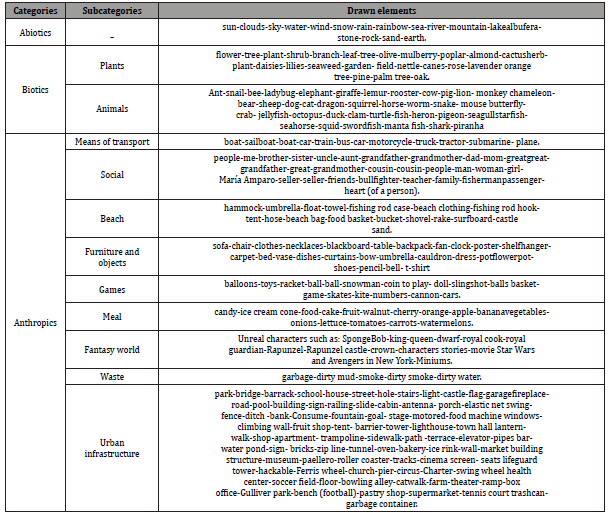
After categorizing all the drawn elements (table 1), we consider establishing criteria with the purpose of following an identical process to coin and name each of the groups of perceptions obtained in the cluster analysis.
The first criterion consisted of assigning a keyword only to the categories and subcategories that had exceeded a 40% difference with respect to the element with the highest percentage. This keyword referred to some element related to the category or subcategory. At the same time, we assigned a code to each keyword to identify it; in this case, we consider the first letter of the keyword as its code (table 2):
The second criterion was to highlight the dominant categories and subcategories, that is, those that exceeded 40% based on the most notable value of the cluster analysis. If for example the highest percentage was 95%, because from there, we highlighted all the categories and subcategories of elements that exceeded 55%; or if the highest value was 100%, they highlighted those that exceeded 60%. In this way, they all had the same relationship.
To better exemplify the process we carry out, we show the data from the first group of environmental perceptions obtained from cluster analysis. This is SPH Perception: the dominant categories and subcategories are those included in Table 3. The ones that are highlighted in bold, means that they have been drawn more frequently. As seen in the table, those that exceeded 40% based on the most notable value are three: Abiotic, Urban infrastructure and Social (Table 3).
Table 2:Keyword and code of dominant categories and subcategories.
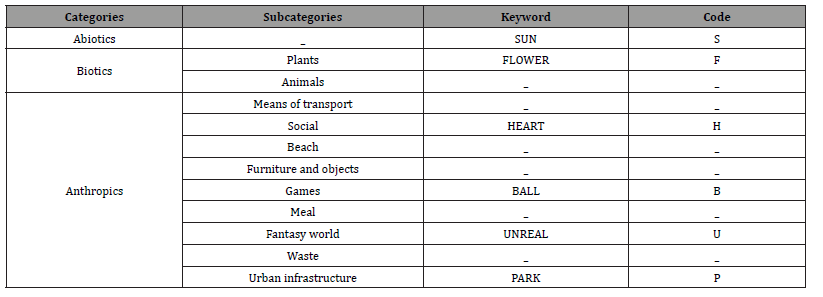
Table 3:Group 1, SPH Perception.
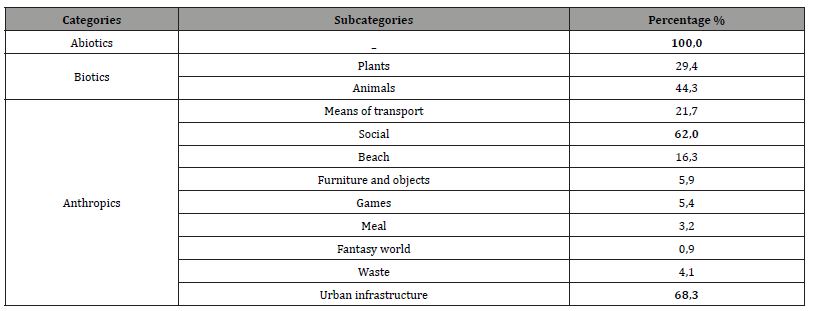
We would like to explain how we coined and named each group of perception obtained in the analysis from the data. First, the underlined categories and subcategories that exceeded a 40% based on the most notable value, we replace them with the keyword assigned to your category or subcategory and we arrange them in descending order, from highest percentage to lowest, according to the results. Thus, following the data in table 3, we have that: Abiotic=Sun; Urban infrastructure=Pak; Social=Heart. This is why, once we reach this point, we use the first initial of each of the keywords (S+P+H) and, with this, we obtained the name of the first type of environmental perception based on the representation and frequency of the elements drawn environmental conditions (figure 1): SPH perception.

Next, we present the third group of perceptions (PF Perception) to serve also as an example. In this group, the dominant categories and subcategories are those that stand out in Table 4 because they exceed 40% based on the most notable value. In this case, the highest value is that of the Urban infrastructure element (100%) and is followed by the Plants subcategory (61.9%) included in Biotics (Table 4).
Table 4:Group 3, PF Perception.
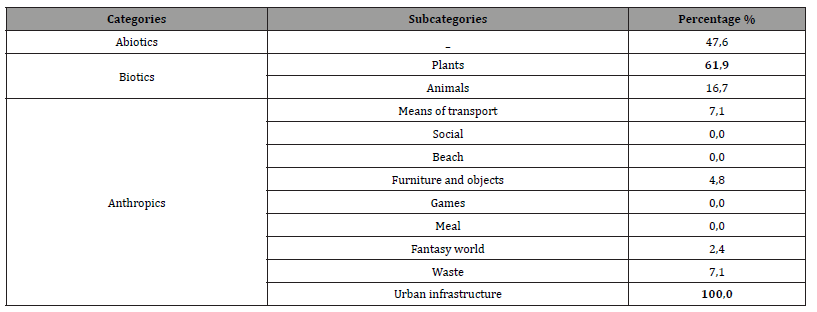
In Figure 2 you can see that, analogously to what was done in group 1, we used the Keywords of the dominant elements: Urban infrastructure=Park; Plants =Flower. Likewise, with the first initial of each of the keywords (P+F) we coin the third group: PF Perception.

Although other types of element categories appear, the predominant ones are Urban infrastructure and Plants. In a similar way to group 1, we can see that, although the predominant categories, other categories, and subcategories. That is, there are some elements from other categories and subcategories that they accompany the most dominant ones and do not occur all at the same time in the same drawings. Likewise, the categories and subcategories that are not represented in the drawings are evident. children: all those that show 0% representation. Hence, the cluster technique and the criteria that we followed helped us to rigorously determine each of the types of perceptions children in this PNA.
Results
Based on the categorization of the environmental elements drawn by the children (table 1), a cluster analysis is carried out that allows identifying groups of homogeneous productions depending on the type of elements that appear in the drawings. For this, a cluster has been used hierarchical that allows classifying the different productions (cases) of the 5-year-old child population who lives in an PNA. A previous exploration has allowed us to identify up to six groups of productions. Table 5 shows the number of productions and percentage that makes up each cluster:
Table 5:Frequency and percentage of perception types based on their elements.

As stated previously, the same method was followed to coin and organize the codes of the names of the groups of perceptions obtained in the cluster analysis. With which, the result obtained was that of Table 6:
Table 6:Distribution and designation of perception types based on their elements.
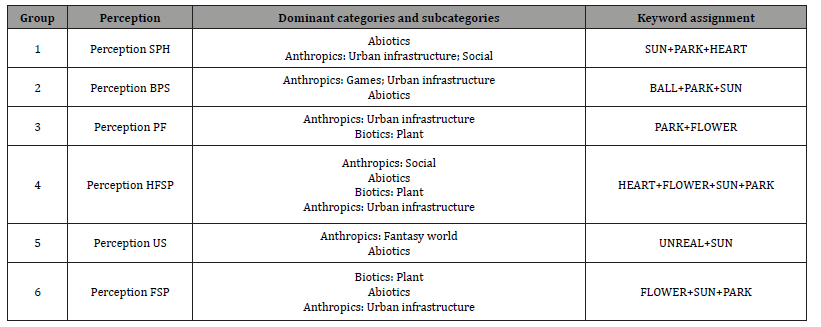
Taxonomy of types of perceptions
Next, we break down and describe the groups obtained
from perceptions based on the percentages of appearance of
environmental elements in each group:
1. Perception SPH. This group is the one that corresponds to
just over half of the perceptions outlined (52.5%). It is defined
by the presence in all drawings of elements of the category
Abiotics (100%), and in approximately two thirds of them, the
subcategories Social (62%) and Urban infrastructure (68.3) in
the Anthropic category. Drawings of this type (figure 3):
2. Perception BPS. Subcategories of the Anthropic category
stand out with a high presence. In descending order, they
appear: Games (100%) and Urban infrastructure (95%). Finally,
there appears Abiotic category (70%). Examples of drawings of
this perception (figure 4):
3. Perception PF. This type is defined by the Urban
infrastructure subcategory (100%) included in the Anthropic
category; it is the majority presence. It is followed by the
presence of the subcategory Plants (61.9%) from the Biotics
category. Examples of drawings of this type of perception
(figure 5):
4. Perception HFSP. It is defined by the presence in all the
drawings of Anthropic elements of the social subcategory
(100%), and in two thirds of them approximately as many
elements Abiotic (68.1%), as well as Urban infrastructure
(63.9%) and Biotic elements, Plants (69.4). It is the second
most represented perception (17.1%). Examples of drawings of
this type (figure 6):
5. Perception US. In this group, in descending order, the
presence of Anthropic stands out Fantasy world (100%) and
is followed by the Abiotic element (70.8%). Other elements
appear biotic and anthropic, but in percentages less than 40%
with respect to the most notable element. Examples of drawings
of this type of perception (figure 7):
6. Perception FSP. The elements with the most presence
in this group is Biotics, Plants (100%). Abiotics (92.5%) and
Anthropics also appear significantly. Urban infrastructure
(70%). Examples of drawings of this type of perception (figure
8):



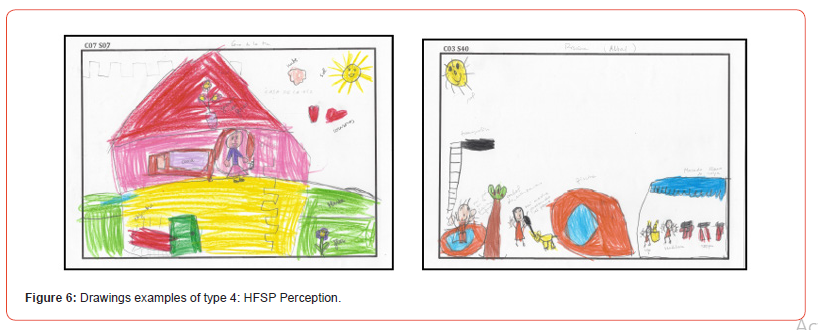
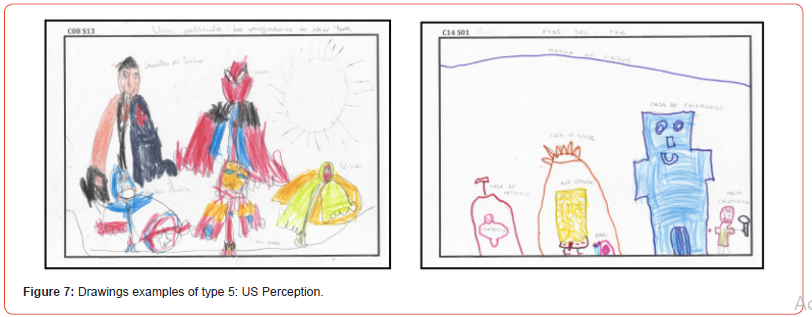
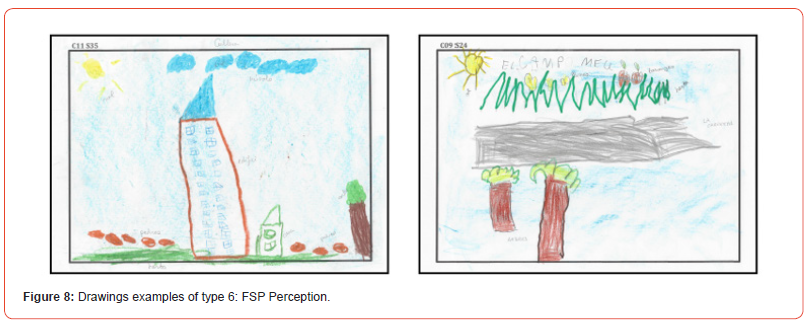
Discourse
The objective of this study was to determine a taxonomy with the different types of environmental perceptions that the child population living in an PNA has.
To carry out the study, three types of environmental elements were considered: abiotic, biotic, and anthropic. 421 drawings made by 5-year-old children of Education were analyzed. Children who live in each of the towns that encompass the Albufera Natural Park, a Protected Natural Area (PNA). Through qualitative and quantitative methods, we analyzed what types of elements were those that predominated in each perception outlined and what groups of perceptions had been drawn more and less frequently. Thus, with cluster analysis, were able to classify different types of environmental perceptions.
From the results, a taxonomy of six groups of perceptions could be established. homogeneous and that have been coined with a name taking into account the elements dominant environmental factors in each type. Therefore, with this study, we provide the following taxonomy of environmental perceptions of young children living in an PNA: SPH perception; BPS Perception; PF Perception; HFSP Perception; US Perception; FSP Perception.
Of all of them, it is worth highlighting the SPH Perception, given that it is the type most outlined by the sample participants. Specifically, a little more than half of the drawings obtained (52.5%) they belong to this type of perception; a type of perception that does not represent biotic elements of the natural space in which these children live, but quite the opposite, the elements of social character and urban infrastructure.
Our results indicate that the perceptions of children who live in an PNA show a notable disconnection of the biotic elements from their natural environment and, on the contrary, a considerable link to anthropic related to its urban environment. And we cannot help but say that the existence of this reality raises concerns because it is considered that there is a loss of taking advantage of the elements of the natural environment and their benefits for children. In that sense, the importance of children interacting with the natural environment through their own experiences [39-45] because even, being a close environment, it remains a great unknown to them. It is evident the distance that exists between children and the natural environment. Therefore, our findings add to those of other authors who consider that it is necessary to strengthen the bond between children and the natural environment because it favors their connection [3,46-49]. In the same way, we recognize the importance of children interacting with the natural environment through them own experiences (39-45] and encourage other teachers and researchers to carry out new studies in this field of knowledge for the improvement of Early Childhood Education.
Finally, we would like to highlight that both our results and those of other researchers in this field, reveal that drawing is an effective language and, therefore, a form of visual communication that provides valuable information to analyze the meaning of young children’s environmental perceptions [20,26,32-34,36,37,50,56, 58,59,61]. Furthermore, the drawing is a pleasant and easy activity for the child, and, in turn, this visual language is like a mirror and reflection of your mind, since it reveals to us what you think, what you know and what you understand; in short, his meaning [33,53- 55,57,60,64] because they are considered expressions full of meaning and understanding [54,62].
To conclude, we would like to emphasize that our work offers a taxonomy of perceptions of young children who live in an PNA and that it could be interesting to do an analysis comparative with children who live in other natural environments. Have the evidence of our study and the taxonomy that determines the different types of perceptions that children have of this natural environment could be interesting to check if other 5-year-old children living in other natural environments have the same types of perception or, on the contrary, perceive more biotic elements of the natural environment in which they live.
Acknowledgment
None.
Conflict of Interest
There is no conflict of interest of any kind.
Notes on Contributor
Amparo Carretón Sanchis, PhD. Her research focuses on Early Childhood Education, specifically in children’s drawings as a representative language to understand their perceptions of the environment.
References
- Bertrand G (1972) Landscape science, a diagonal science. Journal of Geography of the Pyrenees and the South-West 43 (2): 127-133.
- Melhuus EC (2012) Outdoor day-care centers-a culturalization of nature: how do children relate to nature as educational practice? European Early Childhood Education Research Journal 20(3): 455-467.
- Tuan Y (1977) Space and place: The perspective of experience. Edward Arnold.
- Beetlestone F (1998) Creative kids, imaginative teaching. Open University Press, UK.
- Santaella L (1993) Perception: a semiotic theory. São Paulo: Experiment.
- Santaella L (2012) Perception: phenomenology, ecology, and semiotics. São Paulo: Cengage Learning.
- Gibson JJ (2014) The ecological approach to visual perception: Classic edition (1st Edition). Psychology Press.
- Holahan CJ (2015) Environmental Psychology. A general approach. Limusa, Mexico.
- Khzam E (2008) Environmental perception as meaning of the landscape: Theoretical implications from the relationship between the human being and the environment. Total Environment Magazine 1(1): 8-12.
- Maller C, Townsend M, St Leger L, Henderson Wilson C, Pryor A, et al. (2009) Healthy Parks, Healthy People: The Health Benefits of Contact with Nature in a Park Context. George Wright Forum 26(2): 51-83.
- Gaston KJ, Soga M (2020) Extinction of experience: The need to be more specific. People and Nature (Hoboken, NJ) 2(3): 575-581.
- Pergams ORW, Zaradic PA (2008) Evidence for a fundamental and pervasive shift away from nature-based recreation. Proceedings of the National Academy of Sciences of the United States of America 105(7): 2295-2300.
- Soga M, Gaston KJ (2016) Extinction of experience: the loss of human-nature interactions. Frontiers in Ecology and the Environment 14 (2): 94-101.
- Soga M, Gaston KJ, Kubo T (2018) Cross-generational decline in childhood experiences of neighborhood flowering plants in Japan. Landscape and Urban Planning 174: 55-62.
- Griffiths J (2014) Kith: The riddle of the childscape. London, UK: Penguin Books.
- Louv R (2005) Last child in the woods: Saving our children from nature-deficit disorder. London, UK: Atlantic Books.
- Miller JR (2005) Biodiversity conservation and the extinction of experience. Trends in Ecology & Evolution 20(8): 430-434.
- Tonucci F (2012) Science is three years. Guix d'Infantil 68: 11-15.
- Beery T, Jørgensen K (2018) Children in nature: Sensory engagement and the experience of biodiversity. Environmental Education Research 24(1): 13-25.
- Carretón A, García I, García J (2022a) The perception of the environment through drawing in early childhood education. The case of the wetland of the Albufera in Valencia (Spain). Journal of Outdoor and Environmental Education 25(3): 265-287.
- Häggström M (2019) Lived experiences of being-in-the-forest as experiential sharing with the more-than-human world. Environmental Education Research 25(9): 1334-1346.
- Häggström M, Schmidt C (2020) Enhancing children's literacy and ecological literacy through critical place-based pedagogy. Environmental Education Research 26(12): 1729-1745.
- Larimore R (2018) Using Principles of Nature-Based Preschools to Transform Your Classroom. YC Young Children 73(5): 34-41.
- Sobel D (2020) School Outdoors: The Pursuit of Happiness as an Educational Goal. Journal of philosophy of education 54(4): 1064-1070.
- Streelasky J (2019) A Forest‐based Environment as a Site of Literacy and Meaning Making for Kindergarten Children. Literacy 53(2): 95-101.
- Carretón A, García I, García J (2022b) The systemic vision of the environment through drawing of young Spanish children. European Early Childhood Education Research Journal 30 (5): 773-790.
- Muñoz A, Jiménez J, Aranda E, Damiá J, Torremocha F (2012) The guide to falling in love with l'Albufera de Valè Environmental Seduction Project. Valencia: OPA, Valencia City Council.
- Rosenthal R, Rosnow RL (2008) Essentials of behavioral research: methods and data analysis. (3rd). New York: McGraw Hill.
- Creswell JW, Plano VL (2011) Designing and conducting mixed methods research. Thousand Oaks, Sage, CA.
- Creswell JW (2013) ResearchDesign. Qualitative, Quantitative and Mixed Methods Approaches. Sage, London, UK.
- Bryman A (2006) Integrating quantitative and qualitative research: How is it done? Qualitative Research 6(1): 97-113.
- Barraza L, Robottom I (2008) Gaining Representations of Children's and Adults Constructions of Sustainability Issues. International Journal of Environmental & Science Education 3(4): 179-191.
- Bowker R (2007) Children's perceptions and learning about tropical rainforests: an analysis of their drawings. Environmental Education Research 13(1): 75-96.
- Maagerø E, Sunde T (2016) What makes me happy, and what makes me scared? An analysis of drawings made by Norwegian and Palestinian children. European Early Childhood Education Research Journal 24(2): 287-304.
- Marín R (1988) Children's drawing: trends and problems in research on expression plastic of schoolchildren. Art, Individual and Society 1: 5-30.
- Profice C, Pinheiro J, Fandi AC, Gomes AR (2015) Children's environmental perception of protected areas in the Atlantic Rainforest. Psychology: Bilingual Journal of Environmental Psychology 6(3): 328-358.
- Stokas D, Strezou E, Malandrakis G, Papadopoulou P (2017) Greek primary school children's representations of the urban environment as seen through their drawings. Environmental Education Research 23(8): 1088-1114.
- Wu M, Yuan T, Liu Ch (2020) Changing stigma on wild animals: a qualitative assessment of urban pupils' pre-and post-lesson drawings. Environmental Education Research 26(6): 830-848.
- Chawla L, Derr V (2012) The development of conservation behaviors in childhood and youth. In SD Clayton (Ed.), The Oxford handbook of environmental and conservation psychology, Oxford University Press, pp. 7-555.
- Chen Hsuan Cheng JC, Monroe MC (2010) Connection to nature: Children's affective attitude toward nature. Environment and Behavior 44(1): 31-49.
- Clayton S (2003) In S Clayton, S Opotow (Eds.), Environmental identity: A conceptual and an operational definition. Identity and the natural environment: The psychological significance of nature. MIT Press pp. 45-65.
- Mayer FS, Frantz CM (2004) The connectedness to nature scale: A measure of individuals' feeling in community with nature. Journal of Environmental Psychology 24(4): 503-515.
- Nisbet EK, Zelenski JM, Murphy SA (2008) The nature relatedness scale. Linking individuals ‘connection with nature to environmental concern and behavior. Environment and Behavior 41(5): 715-740.
- Raudsepp M (2005) Emotional connection to nature: Its socio-psychological correlates and associations with pro-environmental attitudes and behavior. In B Martens, AG Keul (Eds.), Designing social innovation, Hogrefe, pp. 83-91.
- Schultz PW (2002) Inclusion with nature: The psychology of human-nature relations. pp. 61-78.
- Collado S, Corraliza JA (2013) Children's restorative experiences and self-reported environmental behaviors. Environment and Behavior 47(1): 38-56.
- Cudworth D, Lumber R (2021) The importance of Forest School and the pathways to nature connection. Journal of Outdoor and Environmental Education 24(1): 71-85.
- Cummings F, Nash M (2015) An Australian perspective of a forest school: Shaping a sense of place to support learning. Journal of Adventure Education and Outdoor Learning 15(4): 296-309.
- Hinds J, Sparks P (2008) Engaging with the natural environment: The role of affective connection and identity. Journal of Environmental Psychology 28(2): 109-120.
- Alerby E (2000) A Way of Visualizing Children's and Young People's Thoughts about the Environment: A study of drawings. Environmental Education Research 6(3): 205-222.
- BOE-A-1990-10259. Convention relating to wetlands of international importance, especially as waterfowl habitat, was done at Ramsar on 2 February 1971. Designation of new wetlands by Spain. (s/f). Boe.es.
- BOE-A-2018-10240. Law 7/2018, of July 20, modifying Law 42/2007, of July 13 December, Natural Heritage, and Biodiversity. (s/f). Boe.es.
- Cherney ID, Seiwert SC, Dickey TM, Flichtbeil JD (2006) Children's Drawings: A Mirror to Their Minds. Educational Psychology 26(1): 127-142.
- Cox S (2005) Intention and Meaning in Young Children's Drawing. International Journal of Art and Design Education 24(2): 115-125.
- Ehrlén K (2009) Drawings as Representations of Children's Conceptions. International Journal of Science Education 31(1): 41-57.
- Flowers AA, Carroll JP, Green GT, Larson LR (2015) Using art to assess environmental education outcomes. Environmental Education Research 21(6): 846-864.
- Hopperstad MH (2010) Studying Meaning in Children's Drawings. Journal of Early Childhood Literacy 10(4): 430-452.
- Lefebvre H (1991) The production of space. Blackwell, Cambridge, USA.
- Madden L, Liang J (2017) Young children's ideas about environment: perspectives from three early childhood educational settings. Environmental Education Research 23(8): 1055-1071.
- Maneja R (2010) The perception of the environment in children and adolescent groups. Comparison between La Huacana (Michoacán, Mexico) and the Tordera River basin (NE, Catalonia). Barcelona. doctoral thesis. Autonomous University of Barcelona, Spain.
- Max Neef MA (2005) Foundations of trans disciplinarity. Ecological Economics 53: 5-16.
- Matthews J (1999) The art of Childhood and Adolescence: The Construction of Meaning. London: Falmer Press.
- Pellier AS, Wells JA, Abram NK, Gaveau D, Meijaard E (2014) Through the eyes of Children: Perceptions of Environmental Change in Tropical Forests. PLOS ONE 9(8).
- Ring K (2006) Supporting Young Children Drawing: Developing a Role. International Journal of Education Through Art 2(3): 195-209.
- Schmunck, P Schultz (Eds.). Psychology of sustainable development. Kluwer Academic, pp. 61-78.
- Wright S (2007) Young Children's Meaning-Making Through Drawing and 'Telling': Analogies to Filmic Textual Features. Australian Journal of Early Childhood 32(4): 37-48.
- 12th Meeting of the Conference of the Parties. (s/f). Ramsar.org.
-
Amparo Carretón Sanchis*. Taxonomy of Types of Children’s Perceptions of a Protected Natural Area. Iris J of Edu & Res. 2(2): 2024. IJER.MS.ID.000534
-
Early childhood education, Environmental elements, Environmental perception types, Protected Natural Area, Drawings
-

This work is licensed under a Creative Commons Attribution-NonCommercial 4.0 International License.






